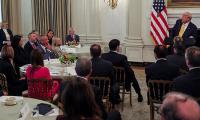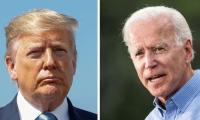The police are not a powerful club in Pakistan: the military is, the judiciary is, intelligence agencies are and even the DMG, but not the police. Cops probably remain the most maligned group in the state and are the easiest to scapegoat. Exhibit? Two cops being the only ones punished in the Benazir Bhutto murder case.
Pending decision on their appeal, the Lahore High Court has suspended the sentences awarded to the police officers (charged under Sections 119 and 201 of the PPC for concealment of design to commit an offence that the police were duty bound to prevent, and for causing disappearance of evidence). The PPP has decided to challenge the decision. Why is the PPP making all this noise now after exhibiting almost no interest in the trial when in power? We are entering an election year. It is time for the PPP to bring back the memory of Benazir Bhutto.
There are a few things we keep being told about BB’s tragic assassination. One, the police ordered that crime scene be washed after one hour and forty minutes of the attack. Two, the police didn’t order an autopsy to be conducted and thus didn’t confirm of BB’s cause of death. And three, part of the police contingent on duty at Liaquat Bagh was sent to attend to the shooting incident involving Nawaz Sharif on Islamabad Highway.
Put together, these three matters constitute the smoking gun that frames cops for aiding and abetting. Let us consider each one of them.
The logic behind highlighting the washing down of part of the crime scene (the entire crime scene wasn’t washed, but only the part that was smeared with the blood of the victims and the bomber) is that it was done to wash away vital evidence that could help determine identity of the attackers. And so it is claimed that if you find who ordered the washing, you’ll get to the root of the conspiracy.
In its order suspending the sentences against the cops the high court asked that if 28 articles of evidence were secured by the police from the crime scene, “then what kind of evidence was destroyed by washing out the spot”? What we know from the record is that the limbs and facemask of the suicide bomber, along with the gun he fired (together with empties), were recovered from the crime scene (along with blood, debris and bodies). From the evidence collected, the appearance of the suicide bomber was reconstructed.
The suicide bomber’s DNA matched the blood on the gun used and the empties that were collected matched the gun. His DNA matched items of clothing recovered from the house of his handlers in Rawalpindi. The handlers, aiders and abettors charged for the assassination and later released by the trial court made admission statements and their story was backed up by phone records and their whereabouts on the fateful days (through geo-fencing).
Rehman Malik, the PPP’s interior minister and in charge of BB’s security at the time of her assassination confirmed this in an article published after the trial court verdict in The News on September 7 this year:
“Baitullah Mehsud fulfilled his claim to kill her with his men with the local support of anti-PPP elements. The police had arrested accused Hasnain Gul and Muhammad Rafaqat on January 5, 2008. They subsequently made confessional statement under Section 164 CrPC before a magistrate, disclosing having picked up accused Nasarullah and two suicide bombers namely Bilal and Ikramullah from Daewoo terminal Rawalpindi on December 26, 2007; providing shelter to them at the house of accused Rafaqat Hussain; having carrying out reconnaissance of Liaquat Bagh on December 27, 2007 and bringing both the suicide bombers to the crime scene for suicide attack on Benazir. Graphic forensic mobile phone confirms the interconnection and presence on the scene. The subsequent call record and RBS locations analysis had corroborated the confessional statements of both the accused Hasnain Gul and Rafaqat Hussain.”
The Scotland Yard team had reached the same conclusion in February 2008:
“All the available evidence points toward the person who fired shots and the person who detonated the explosives being one and the same person…Body parts from only one individual remain unidentified. Expert opinion provides strong evidence that they originate from the suicide bomber…Analysis of the media footage places the gunman at the rear of the vehicle and looking down immediately before the explosion. The footage does not show the presence of any other potential bomber…The inevitable conclusion is that there was one attacker in the immediate vicinity of the vehicle in which Ms Bhutto was travelling.”
Scotland Yard had critiqued procedures for collection of evidence etc, but had affirmed that “the evidence that is available is sufficient for reliable conclusions to be drawn” regarding the cause and circumstances of BB’s death. With the identity of the killer and handlers determined beyond doubt, along with the mode of attack, what more could be found at the crime scene?
The second issue flagged is that of autopsy. The prosecution’s case was that the cause of death was skull injury caused by impact against the escape hatchet of the armoured vehicle. In its report, Scotland Yard reproduced findings of the UK Home Office pathologist, Dr Nathaniel Cary, who stated that, “the only tenable cause for the rapidly fatal head injury in this case is that it occurred as the result of impact due to the effects of the bomb-blast…in my opinion Mohtarma Benazir Bhutto died as a result of a severe head injury sustained as a consequence of the bomb-blast and due to head impact somewhere in the escape hatch of the vehicle.”
Scotland Yard concluded that, “Ms Bhutto’s injury is entirely consistent with her head impacting upon the lip of the escape hatch. Detailed analysis of the media footage provides supporting evidence. Ms Bhutto’s head did not completely disappear from view until 0.6 seconds before the blast. She can be seen moving forward and to the right as she ducked down into the vehicle. Whilst her exact head position at the time of the detonation can never be ascertained, the overwhelming conclusion must be that she did not succeed in getting her head entirely below the lip of the escape hatch when the explosion occurred.”
Asif Zardari stated on record that he did not grant permission to conduct an autopsy. There is no credible alternative theory on the cause and circumstances of BB’s death. Her head had no exit wound and the X-ray conducted at RGH confirmed that there was no bullet in the head. Given that there is neither any doubt about who attacked BB nor about the cause of death, the washing of the blood at the crime scene (which isn’t prohibited by law) or the lack of an autopsy becomes irrelevant.
The third issue involved a decision to send an ASP with his team to attend to the Islamabad Highway incident. Record suggests that box security around BB’s vehicle was intact at the time of attack. The SP punished by the trial court was only meters away at the time of the attack. The attack took place outside Liaquat Bagh when BB’s jeep was on the road and a police escort vehicle that wasn’t damaged in the attack followed BB’s vehicle toward the hospital. What would another ASP and his team have done in this case?
There is broad consensus amongst those who have analysed the circumstances surrounding BB’s assassination that the attack was executed by operatives of Al-Qaeda/TTP on Baitullah Mehsud’s orders, as detailed by Rehman Malik in his article. The controversy is thus limited to the motive of the attack: was Baitullah motivated by personal hate for a liberal female leader opposed to his ilk or did he do so on someone else’s behest? With Baitullah and all his underlings claimed by drones, we will never find out.
The cops can only be blamed if we conclude that no suicide attack can ever be carried out without security forces being complicit. In relation to dozens of suicide attacks across Pakistan that have claimed thousands of lives, this is the only one where we have attributed blame on such flimsy basis.
The writer is a lawyer based in Islamabad.
Email: sattar@post.harvard.edu
Without right policies and infrastructure, country risks falling behind in rapidly evolving landscape
Today, journalism in Pakistan is not just suffering under oppression; it is also being hollowed out from within
Streak of light at end of dark tunnel should keep generating hope that one is on right path
Mid-1990s was period during which Pak-India Peace Forum was taking shape
Historically, rise and fall of many empires have been directly linked to social justice
This classification was used to distinguish these indigenous groups from others after their conversion to Islam







